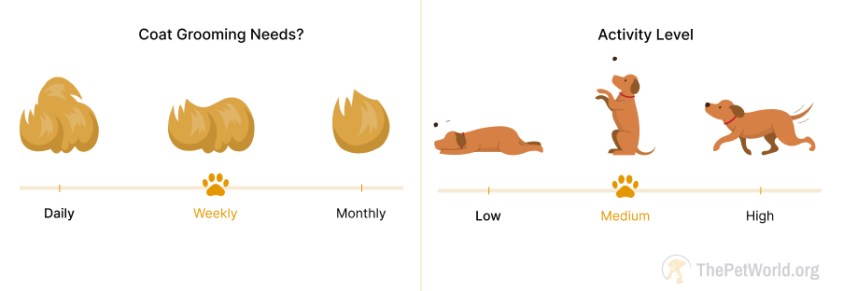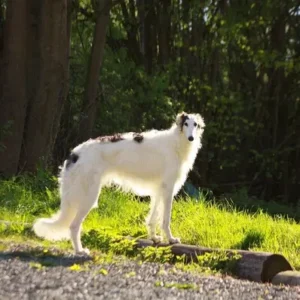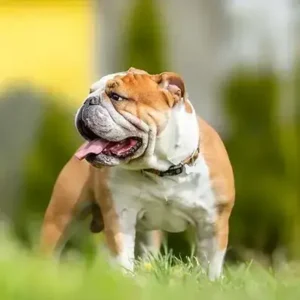Dachshund History/Origin
Dachshunds were once called badger dogs. They got this name in Germany, where they originated and were bred to hunt small prey. In the 18th and 19th centuries, their long but small size, powerful feet, and fearless nature were used to dig into badger holes. Their loud bark, which you hear today, once directed humans to their whereabouts underground.
These purebred dog breed’s unique features, like their paddle-shaped paws, loose skin, deep chests, and loud bark, made them ideal for hunting both above and below ground. Dachshunds were illustrated as early as the 15th century and mentioned in documents from the 16th century. They were used not only for badgers but also for foxes and, in packs, for wild boar.
Dachshunds History- Source: AKC.org
In the 1800s, they transitioned from hunting dogs to companion pets, becoming favorites in royal courts across Europe, including Queen Victoria’s. Their popularity led to the creation of the Miniature DachshundDachshunds gained recognition from the American Kennel Club in 1885 under Hound Group.
The Dachshund Club of America was then founded in 1895. The two World Wars were tough on the breed due to their German association, but since the 1950s, they have been among the most popular dogs in the USA. While still used as hunting dogs in some parts of Europe, in the USA they are known as great family pets. Today, Dachshunds rank sixth among the breeds recognized by the AKC.
- Origin
Originating in Germany, the Smooth Haired Dachshund was the first variety, created from crossing the Braque d’Auvergne and the Pinscher, and possibly the French Basset Hound. Meanwhile, the Wire Haired and Long Haired Dachshunds likely come from crossings with Spaniels and Terriers. Known as the Teckel in Germany, the breed was refined over many years by German foresters to develop a fearless, elongated dog that could dig into burrows and confront prey.
Dachshund Personality
Known for their cleverness, liveliness, and courage, Dachshunds can exhibit stubbornness due to their breeding for perseverance. Despite their fearless reputation, their greatest desire is often to cuddle with their human companions.
The Dachshund’s personality can vary with coat type, with wire-haired Dachshunds being mischievous, longhairs calm, and smooths falling somewhere in between. Temperament can also be affected by factors such as heredity, training, and socialization.
- Dachshund Temperament
Temperament in Dachshunds can vary widely, influenced by factors like heredity, training, and socialization. Dachshund puppies with pleasant temperaments are curious, playful, and enjoy interacting with people.
Ensuring early socialization and exposure to various experiences helps them develop into well-rounded dogs. Enrolling them in puppy kindergarten classes and introducing them to different environments, sounds, and sights from a young age contributes to their social development.
- Potential Challenges
Dachshunds are known for their cleverness, liveliness, and courage, making them beloved companions for many. However, their stubbornness, stemming from their breeding for perseverance, can sometimes present training difficulties.
Additionally, Dachshunds may exhibit possessiveness over toys, and they tend to bark if they feel lonely, potentially leading to separation anxiety. Furthermore, their small size and short coats make them sensitive to cold weather, necessitating protective measures such as sweaters during winter walks.
Dachshund Physical Appearance
These are one of the dog breeds that have unique body shape features short legs and long torsos, while their feet are relatively large compared to their legs. Other distinguishing characteristics include elongated heads, long muzzles, droopy ears, and straight tails.
- Size
The Dachshund comes in various sizes and fur types: smooth, wire-haired, and long-haired, with standard, tweenie, and mini variations within each category.
- Standard:16 and 32 lbs.
- Tweenie: 11 and 16 lbs.
- Miniature: 11 lbs or less.
Standard Dachshund – Source: Unslpash
Miniature Dachshund – Source: Unslpash
Tweenie Dachshund – Source: Pixabay
- Coat color
Dachshunds exhibit a wide range of coat colors and markings, boasting over 20 variations. Popular hues include red, black, and tan, along with the eye-catching dapple pattern. Furthermore, their coat styles can differ significantly:
- Smooth-haired Dachshunds: Short and Shiny hair.
- Long-haired Dachshunds: Slightly Wavy and Long hair.
- Wire-haired Dachshunds: Thick, Short, and Hard overcoats with soft undercoats.
Dachshund Gender Differences
Dachshunds vary in size and temperament based on their gender. These differences can influence their behavior and interactions with their owners. However, it’s important not to stereotype them solely based on gender; each dog is an individual with a unique personality.
- Size
Male standard Dachshunds typically stand 8–9 inches tall as adults and weigh between 16–32 pounds, while female standard Dachshunds have an average height of 7–9 inches and an average weight of 16–32 pounds as adults.
- Temperament
Male Dachshunds are usually more affectionate and cuddly than females. They enjoy cuddling for long periods. They’re playful and silly, open to meeting new people and forming strong bonds with children, making them great family pets. However, they may show more aggression than females, so it’s important to watch them around infants.
Dachshund Feed/Nutrition
The recommended daily food intake for Dachshunds is between 1/2 to 1 1/2 cups of high-quality dry food. However, the amount can vary based on factors like size, age, metabolism, and activity level. Remember that every dog is unique, so adjust the portion according to your dog’s individual needs.
Additionally, investing in high-quality dog food ensures better nourishment, meaning you may need to feed your dog less compared to lower-quality options.
You can also add strawberries as a healthy treat, as they are rich in antioxidants, vitamins, and fiber.
Dachshund Health
Not all Dachshunds will experience these diseases, but it’s crucial to be aware of them if you’re considering this breed.
- Intervertebral Disc Disease: IVDD is a degenerative condition affecting the cushions between the vertebrae in the spine, leading to pain, weakness, and potentially paralysis.
- Epilepsy: Dachshunds are prone to epileptic seizures, which may be genetic or caused by head trauma. If your Dachshund has seizures, consult your vet for appropriate treatment. Epilepsy can often be managed with medication.
- Progressive Retinal Atrophy: PRA is a degenerative eye disorder that causes blindness by destroying photoreceptors. It is detectable years before blindness occurs. Despite blindness, dogs can live full lives by relying on other senses. Reputable breeders test for PRA and avoid breeding affected dogs. A DNA test for PRA is available for miniature longhaired Dachshunds.
- Canine Gastric Torsion: Also known as bloat, GDV is a life-threatening condition where the stomach fills with gas and twists. This can prevent the dog from belching or vomiting, causing shock. Immediate veterinary attention is essential. Symptoms include a distended abdomen, excessive salivation, retching, restlessness, lethargy, and rapid heart rate.
- Cushing’s Disease: This condition occurs when the body produces too much cortisol, either due to glandular imbalance or excessive cortisol from other conditions. Signs include excessive urination and drinking. Treatments range from gland removal to medication.
- Deafness: Hearing loss can occur in double-dapple Dachshunds. Ask if the puppy and its parents were BAER (Brainstem Auditory Evoked Response) tested. This test is available at large specialty practices and veterinary schools.
Breeders might provide health clearances, but these are only issued to dogs older than two years, as some health problems appear later. It’s recommended that breeding dogs be at least two or three years old. Regardless of initial health, prepare for potential health issues throughout your dog’s life. A pet insurance plan can help cover veterinary needs.
Dachshund Care and Grooming
Although Dachshunds do shed, it is minimal, so you won’t need to vacuum frequently. They don’t need baths often unless they’ve rolled in something smelly. They require minimal grooming. Wire-haired Dachshunds require regular brushing and stripping once or twice a year. Long-haired Dachshunds need frequent brushing to prevent tangles and knots.
They also need more frequent baths and benefit from blow-drying afterward. Regular ear cleaning is necessary, at least once a week, using a cotton ball without going too deep.
Their nails need trimming once a month, and their teeth should be cleaned daily to prevent any dental disease. Additionally,potty training your dog is essential to establish good habits and maintain a clean environment.
Dachshund Rescue Groups
If you’re looking to adopt a Dachshund, consider rescue groups that specialize in Dachshund breeds.
Dachshund Price
The price of a Dachshund typically ranges from $1,200 to $3,500, depending on factors such as breeder reputation, pedigree, and location.
When looking to purchase a Dachshund puppy, make sure to buy from a reputable breeder who specializes in Dachshunds. It’s important to choose a breeder who follows ethical breeding practices and conducts health screenings.
Interesting Facts
- The mascot for the 1972 Munich Olympic Games was a Dachshund named Waldi. It was the first time the Olympics had a mascot. The marathon route that year was planned to look like a Dachshund.
- Dachshunds usually live longer than most breeds, averaging between 12 and 15 years. Some Dachshunds, like Chanel and Scolly, have even held the Guinness World Record for the oldest living dog, living to be 21 and 20 years old, respectively.
- In “The Simpsons,” a Dachshund named Santa’s Little Helper plays a prominent role as a central character in the animated series.
The Simpsons- Source: Wikipedia
Best For
The Dachshund can be a perfect pet for individuals or families who are looking for a loyal, affectionate, and playful companion. They are well-suited for owners who have the time and patience to train and socialize them properly. Additionally, those who enjoy spending time outdoors and engaging in activities like walking or playing fetch would also be ideal candidates for having a Dachshund as a pet.
Top Names
| Male Dachshund Names | Female Dachshund Names |
| Max | Daisy |
| Charlie | Bella |
| Oscar | Lucy |
| Cooper | Molly |
| Buddy | Chloe |









 Dachshunds History- Source:
Dachshunds History- Source: 
 Standard Dachshund – Source:
Standard Dachshund – Source:  Miniature Dachshund – Source:
Miniature Dachshund – Source:  Tweenie Dachshund – Source:
Tweenie Dachshund – Source:  Smooth-haired Dachshund- Source:
Smooth-haired Dachshund- Source:  Long-haired Dachshunds – Source:
Long-haired Dachshunds – Source:  Wire-haired Dachshund- Source:
Wire-haired Dachshund- Source:  Black and tan Dachshund – Source:
Black and tan Dachshund – Source: 
 The Simpsons- Source:
The Simpsons- Source: 






